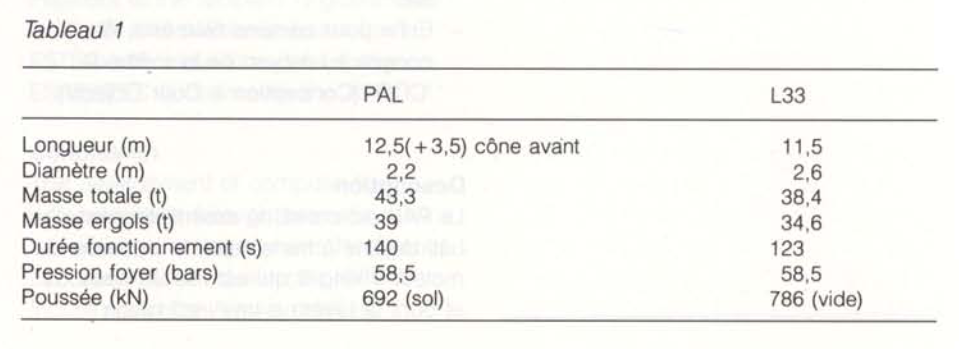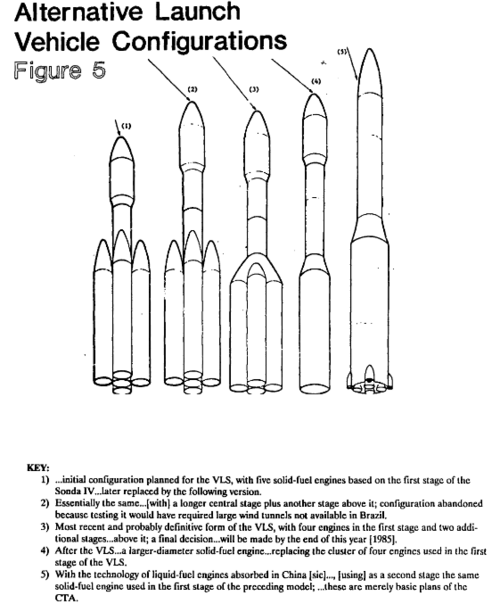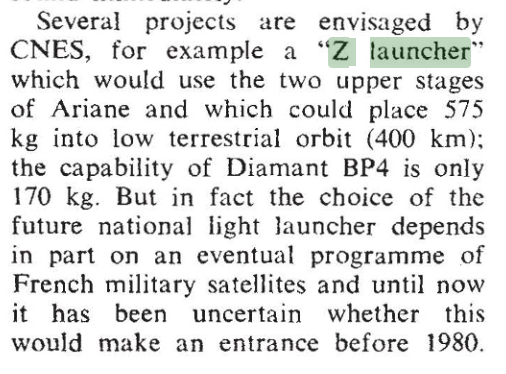TheKutKu
ACCESS: Secret
- Joined
- 13 February 2023
- Messages
- 399
- Reaction score
- 1,097
In the 70s, Brazil was slowly trying to develop its space technologies, which resulted to the Brazilian Complete Space Mission (MECB) program and the ill-fated VLS-1, but while digging a bit around it, I found that before deciding on the VLS design circa 1980, there was a period of time of a few years where France and Brazil were closely cooperating with the goal of jointly developing a launcher.
Some introduction to it in english
https://dspace.mit.edu/handle/1721.1/12739 (p. 100)
And it being named (Projeto BR-2) in French (just says that CNES - French space agency - and French industrials were involved)

 books.openedition.org
books.openedition.org
https://www.researchgate.net/public...l_e_a_Franca_na_Exploracao_do_Espaco_Exterior
An interesting and detailled Portuguese-language paper talking about it
some additional documents talking about it
The context of these programs were Franco-Brazilian partnerships starting in 1967 that had already resulted in preliminary studies on the Natal Ariane tracking station as well as high altitude balloons; and the 2nd Basic Plans for Scientific and Technological Development (PBDCT) in 1976; In july 1976 the Brazilian Space Activities Commission (COBAE) and CNES signed an accord to study a "Complete Space Mission". The CNES proposed the BR-1 Project, which would include the building of three launchers and three satellites.
The BR-1 Franco-Brazilian launcher would use
-S1 derived from the Améthyste L17 of the Diamant BP4
-S2 had three choices: either the P4 second stage of the Diamant BP4 (itself derived from the IRBM RITA), or a similar, brazilian made P4 upper stage of 1.5m ⌀, or a brazilian made P4 upper stage of 1m ⌀.
-S3 would use the P07 stage, "used by the Diamant", there is some confusion about whether this would be the Diamant BP4's P068, or if it is the P07, a planned Ariane 1 fourth stage to launch Exosat, eventually cancelled when it was launched on a Delta 3000.
Payload to LEO would be 150kg, vs 115kg for Diamant BP4.
If the French S2 was to be used, then this launcher (which would substantially be a Diamant BP4) could be launched as early as 1982 with a franco-brazilian satellite, but only out of Kourou because of the military nature of the S2; If a Brazilian S2 was selected, then the NET date would be 1985, but a launch from Brazil was possible. The cost of the program was estimated between $230 million - $500 million USD depending on the chosen architecture.
This project would evolve into the BR-2, which kept the same basis, but with a new launcher, its first meeting was in march 1979.
There is confusion about whether the BR-2 would be a Three (the researchgate link) or two (the two below) stages launcher, but either way they shared the same liquid S1 with solid upper stage(s)
The First stage would be a 40 tons, 2.2m ⌀ stage powered by a single Viking 5 engine (N2O4/UDMH);
There is no information on the second stage
Payload to LEO would be 250kg
The three launches would be from a space center in Natal, but the possibility of using Kourou or another space center in Brazil was considered.
The three earth-observing satellites would have a lifespan of 2 years, with one of them 3-axis-stabilised and launched on a polar orbit.
Launches would happen in the 1987-1989 period.
Activity on the BR-2 was "intense" from march to july 1979, on the french side, Aerospatiale and SEP were involved.
The cost of the BR-2 was significantly higher, and needed large infrastructures to handle the hypergolic fuel.
The french were willing to make significant concessions, however there was a main disagreement on the fuel of the first stage, the Brazilian industry and military prefered a solid-powered S1, which would have more industrial synergy with their relatively succesful sounding rocket and Export-oriented MLRS programs; meanwhile the french considered these programs as an opportunity to keep producing Diamant stages or Viking engines for the foreseeable future (the transition between Diamant BP4 and Ariane 1 was a tough one, and later, in the 2000s, the end of the viking production line caused layoffs for SEP/SNECMA/Safran). Neither side were willing to yield on this point.
There also was uncertainty over the possibility of propulsion technology transfer, maybe not without reasons, 10 years later, the MTCR would shut down Arianespace's attempt at selling Viking engines to brazil.
After a trial period, in November 1979, the Brazilians decided to go for an indigenous program, which would be cheaper ( $482M USD, vs $1.7B USD for the Franco-Brazilian program, with about a billion paid by brazil), this indigenous program became the VLS.
I would appreciate if anyone had more information on these projects, including technical documents or drawings.
Personally I think it's a shame that France's and Brazil's space programs didn't become closer, with both countries' space infrastructures 1000 km from each other, there was potential for significant synergy and integration.
Some introduction to it in english
https://dspace.mit.edu/handle/1721.1/12739 (p. 100)
And it being named (Projeto BR-2) in French (just says that CNES - French space agency - and French industrials were involved)

Le Centro técnico aerospacial CTA (Centre technique aérospatial)
Le Centro técnico aerospacial (Centre technique aérospatial) est un organisme d’enseignement et de recherche du Departamento de pesquisas e desenvolvimento (Département recherches et développement) du ministère de l’Aéronautique (Ministétio da Aeronáutica). Fondé dès les années 1950, il...
https://www.researchgate.net/public...l_e_a_Franca_na_Exploracao_do_Espaco_Exterior
An interesting and detailled Portuguese-language paper talking about it
some additional documents talking about it
The context of these programs were Franco-Brazilian partnerships starting in 1967 that had already resulted in preliminary studies on the Natal Ariane tracking station as well as high altitude balloons; and the 2nd Basic Plans for Scientific and Technological Development (PBDCT) in 1976; In july 1976 the Brazilian Space Activities Commission (COBAE) and CNES signed an accord to study a "Complete Space Mission". The CNES proposed the BR-1 Project, which would include the building of three launchers and three satellites.
The BR-1 Franco-Brazilian launcher would use
-S1 derived from the Améthyste L17 of the Diamant BP4
-S2 had three choices: either the P4 second stage of the Diamant BP4 (itself derived from the IRBM RITA), or a similar, brazilian made P4 upper stage of 1.5m ⌀, or a brazilian made P4 upper stage of 1m ⌀.
-S3 would use the P07 stage, "used by the Diamant", there is some confusion about whether this would be the Diamant BP4's P068, or if it is the P07, a planned Ariane 1 fourth stage to launch Exosat, eventually cancelled when it was launched on a Delta 3000.
Payload to LEO would be 150kg, vs 115kg for Diamant BP4.
If the French S2 was to be used, then this launcher (which would substantially be a Diamant BP4) could be launched as early as 1982 with a franco-brazilian satellite, but only out of Kourou because of the military nature of the S2; If a Brazilian S2 was selected, then the NET date would be 1985, but a launch from Brazil was possible. The cost of the program was estimated between $230 million - $500 million USD depending on the chosen architecture.
This project would evolve into the BR-2, which kept the same basis, but with a new launcher, its first meeting was in march 1979.
There is confusion about whether the BR-2 would be a Three (the researchgate link) or two (the two below) stages launcher, but either way they shared the same liquid S1 with solid upper stage(s)
The First stage would be a 40 tons, 2.2m ⌀ stage powered by a single Viking 5 engine (N2O4/UDMH);
There is no information on the second stage
Payload to LEO would be 250kg
The three launches would be from a space center in Natal, but the possibility of using Kourou or another space center in Brazil was considered.
The three earth-observing satellites would have a lifespan of 2 years, with one of them 3-axis-stabilised and launched on a polar orbit.
Launches would happen in the 1987-1989 period.
Activity on the BR-2 was "intense" from march to july 1979, on the french side, Aerospatiale and SEP were involved.
The cost of the BR-2 was significantly higher, and needed large infrastructures to handle the hypergolic fuel.
The french were willing to make significant concessions, however there was a main disagreement on the fuel of the first stage, the Brazilian industry and military prefered a solid-powered S1, which would have more industrial synergy with their relatively succesful sounding rocket and Export-oriented MLRS programs; meanwhile the french considered these programs as an opportunity to keep producing Diamant stages or Viking engines for the foreseeable future (the transition between Diamant BP4 and Ariane 1 was a tough one, and later, in the 2000s, the end of the viking production line caused layoffs for SEP/SNECMA/Safran). Neither side were willing to yield on this point.
There also was uncertainty over the possibility of propulsion technology transfer, maybe not without reasons, 10 years later, the MTCR would shut down Arianespace's attempt at selling Viking engines to brazil.
After a trial period, in November 1979, the Brazilians decided to go for an indigenous program, which would be cheaper ( $482M USD, vs $1.7B USD for the Franco-Brazilian program, with about a billion paid by brazil), this indigenous program became the VLS.
I would appreciate if anyone had more information on these projects, including technical documents or drawings.
Personally I think it's a shame that France's and Brazil's space programs didn't become closer, with both countries' space infrastructures 1000 km from each other, there was potential for significant synergy and integration.









